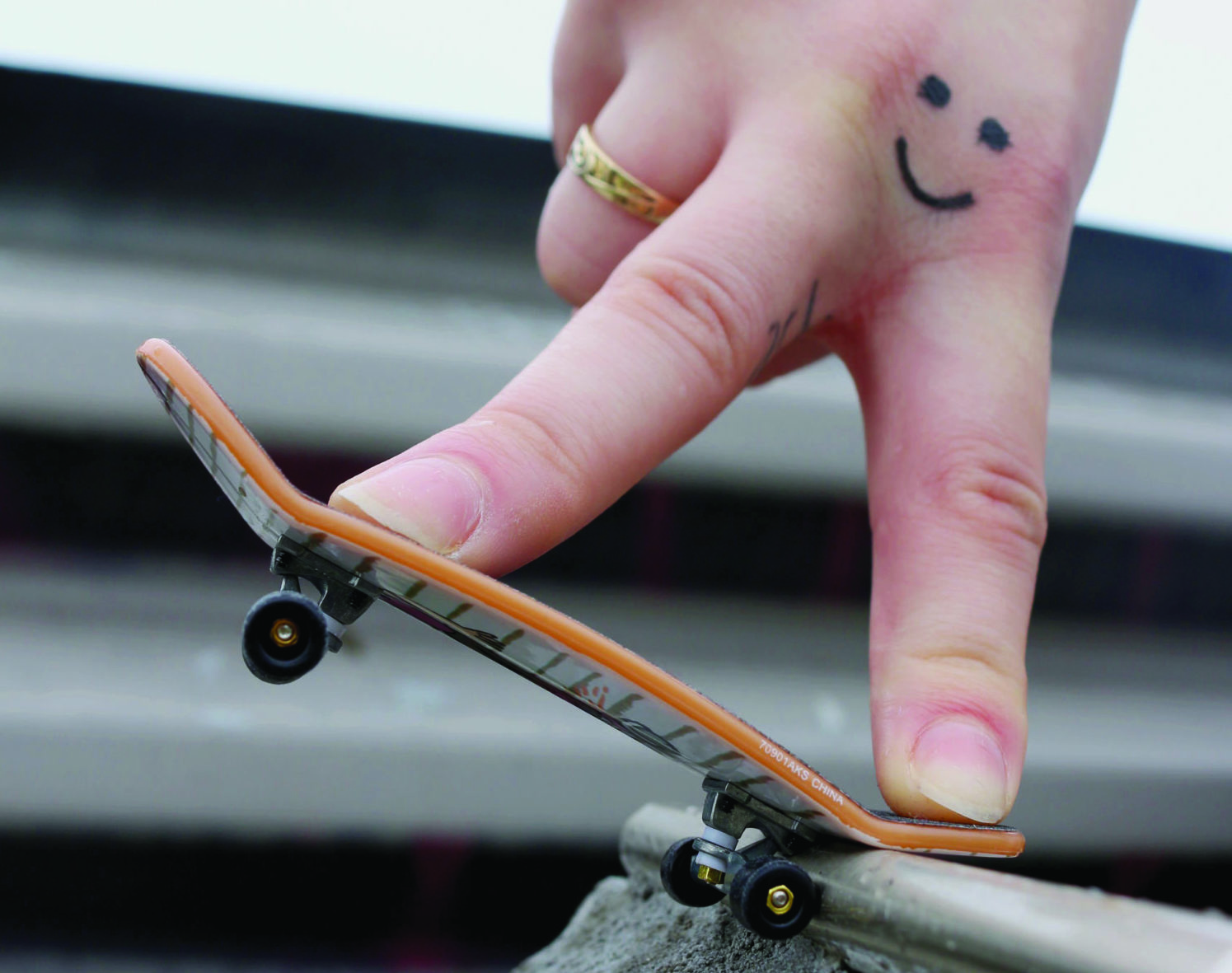Tech decks are miniature skateboards around 96mm in length and that you can control with your fingers. They come with real skateboard parts like wheels, trucks and grip tape but they’re scaled down to fit in your hand.
You can use them on your desk, table or ramps designed for finger boarding. People use them for fun and take it seriously to learn tricks, building parks and even join competitions.
This isn’t just a toy. For majority it’s a hobby and teaches coordination, creativity and patience. And because it’s small, you can do it anywhere.
Here’s how it works, why people enjoy it and what to look out for if you’re getting into tech decks.
What Are Tech Decks?
Tech decks are plastic or wooden fingerboards. They mimic real skateboards but just in miniature form. You ride them using two fingers which are index and middle fingers.
They first became popular in the late 1990s. Since then they’ve gone through waves of interest. People collect them and focus on doing tricks like kickflips, ollies and grinds.
Each deck usually has:
- A printed graphic on the bottom
- Grip tape on top
- Two trucks (the metal parts under the board)
- Four wheels
- Screws and nuts to hold it together
Most tech decks come pre-assembled but few let you build your own. You can also swap out parts to customize them which ads attraction to it.
Why People Use Tech Decks
People get into tech decks for different reasons. Few grew up skateboarding and want something they can use indoors and some like building ramps and parks. Some just enjoy collecting the designs.
Here are a few reasons people stick with it:
- It’s portable
You can carry it in your pocket. Use it at your desk, during a break or even while waiting for a bus. - Low cost
Compared to actual skateboarding, tech decks are cheap. A basic one doesn’t cost much and even upgrades aren’t too expensive. - Learning curve
The tricks take time and when you land one cleanly it feels good. It’s like solving a puzzle with your fingers. - Creative space
You can build parks from cardboard, wood or official kits. Some people design entire setups in their rooms. - Community
There’s a solid online scene for YouTube videos, tutorials, Instagram clips and even competitions.
How to Use a Tech Deck
Using a tech deck is simple to start but hard to master. Here’s the basic method:
- Place your index and middle finger on the board as index at the front and middle at the back.
- Push down with your back finger to pop the board up.
- Slide your front finger forward to level it in the air.
That’s how an ollie works. Here you can learn more tricks like:
- Kickflip – flick the board to make it spin sideways
- Shuvit – rotate the board 180 degrees
- Manual – balance on just the back wheels
- Grind – slide on the trucks across an edge or rail
It takes practice. A lot of people watch slow-motion videos to understand the motion.
Types of Tech Decks
There are a few types of fingerboards you’ll see. Tech Deck is a brand but people often use the term for any fingerboard. Here’s a breakdown:
- Plastic tech decks
It’s pre-assembled and easy to find in toy stores as well as good for beginners. - Wooden fingerboards
It’s custom-made or from niche brands but better grip, smoother feel and more durable. - Custom builds
You can buy separate decks, trucks and wheels. This lets you adjust the board to how you like it. - Collectible decks
Few tech decks have real skateboard brand graphics. People collect them like trading cards. - Parks and ramps
You can buy or build mini skate parks with ramps, rails and stair sets. Few are cardboard and others are made of plastic or wood.
Pros and Cons
Pros:
- Cheap to start
- Doesn’t take up space
- Fun and challenging
- Builds fine motor control
- Can be a social or solo hobby
Cons:
- Easy to lose parts
- Some tricks can be frustrating
- Cheaper decks may break easily
- Hard to find in some areas
Like most hobbies it depends on what you put into it. If you stick with it you’ll improve and probably enjoy it more.
Building Your Own Setup
If you’re serious about tech decks then you might want to build your own. Here’s how that usually works:
- Choose a deck – Plastic or wood. Look for one that fits your hand.
- Pick trucks and wheels – Metal trucks last longer. Urethane wheels grip better.
- Apply grip tape – Just like a real skateboard and this helps your fingers hold the board.
- Assemble with tools – Most parts come with a mini screwdriver. Take your time tightening the screws.
How to Practice Tricks
Start simple and don’t worry about complex moves until you’ve got the basics. Here’s a simple order to follow:
- Ollie
- Manual
- Pop shuvit
- Kickflip
- Grinds
Practice on a smooth surface as wooden table works fine. Avoid carpet as the wheels won’t roll. Watch videos but slow them down and copy the motion. Your fingers will learn over time and set goals. Land a clean ollie ten times in a row then move to the next trick.
Tech Deck Culture
There’s a real subculture behind tech decks. Online videos, trick contests, people building their own ramps out of foam or wood. You’ll find communities on Instagram, Reddit and YouTube. Some creators share tutorials, do challenges or just post clips of clean tricks and events exist too. Fingerboard meets, trick battles and small tournaments. These might be local or online. If you enjoy learning and creating then there’s room for you in the scene. You don’t need fancy gear to join.
Maintenance and Care
These things are small so they break or loosen easily. Keep a small bag or box to store your gear.
- Tighten the trucks if the board feels wobbly
- Clean the wheels if they stop spinning well
- Replace stripped screws if needed
- Avoid using it on rough surfaces
If you’re using wood decks then avoid water as moisture can warp the board.
For Parents
If your kid is into tech decks then it’s a safe hobby. It builds focus and patience and kids use it to get into real skateboarding. Kids also enjoy collecting or building.
It doesn’t need screens and they can play indoors. It’s quiet harmless and just keep track of small parts as they get lost easily. Start with a basic plastic deck. If they enjoy it then they can explore ramps or custom parts later.
Final Thoughts
Tech decks are simple but they offer a lot of fun, challenge, creativity and community. You don’t need a skatepark or even a lot of space, just a table and time. Whether you want to kill time or get good at tricks, tech decks give you something to do with your hands. You’ll mess up at first and that’s normal. With time your fingers get better and the tricks start to land and that’s where it gets fun.
FAQs
1. Are tech decks just toys?
Not really. They started as toys, but many people treat them as a real hobby. Some learn serious tricks and even build full parks.
2. What’s the difference between a tech deck and a fingerboard?
Tech Deck is a brand. Fingerboards is the general term. Some fingerboards are plastic, some are wood and not all are made by Tech Deck.
3. Can you actually learn tricks on a tech deck?
Yes. You can do tricks like kickflips, manuals and grinds. It takes practice but people can get very skilled.
4. Do tech decks help with real skateboarding?
A little but they can help you understand trick motion. They won’t build the balance or leg strength needed for actual skating.







